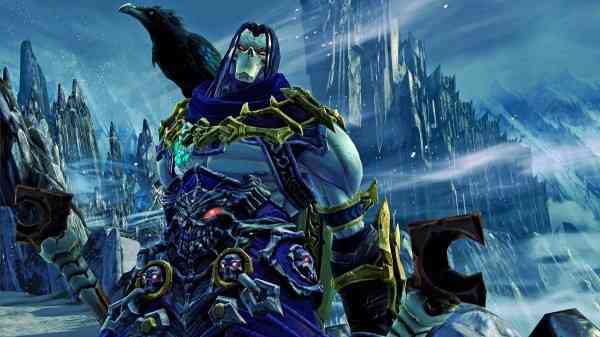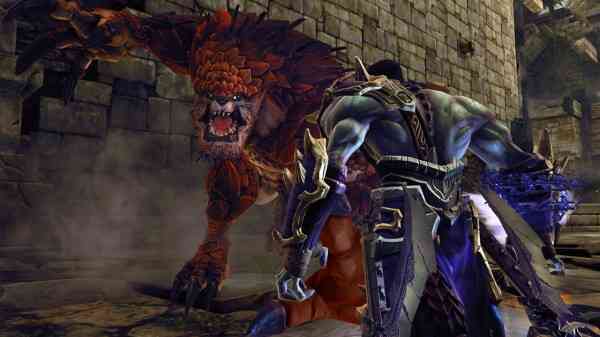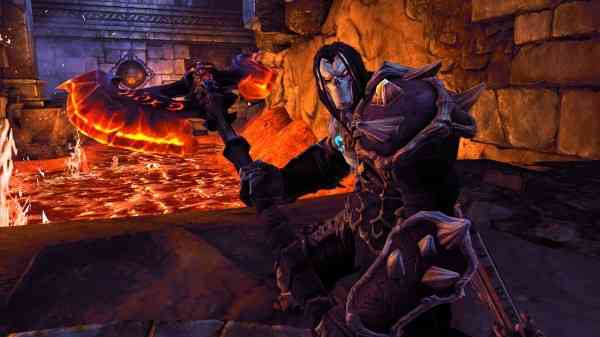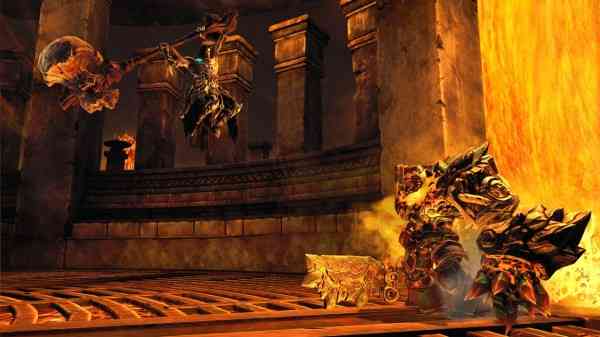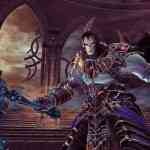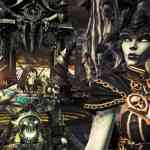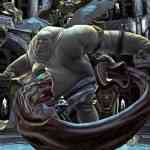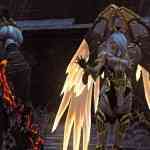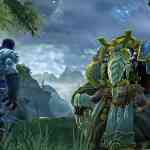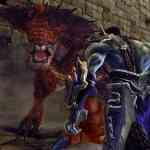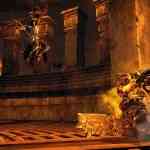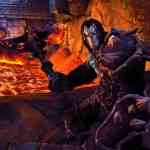THQ is a publisher that has experienced some struggles lately, and if there is one thing that could help change things around it is a good title that gamers everywhere can enjoy. Darksiders II has been highly touted as the next great thing from THQ. The sequel to the original Darksiders, which was released in 2010, has some pretty big shoes to fill, as the original game was critically, and commercially, well received. Well, after spending the last week and a half or so playing the sequel I have to say that Darksiders II not only lives up to the original, it exceeds it.
The story in Darksiders II is a deep and engaging one. Without saying too much, as I do not want to spoil it for you, a new protagonist is introduced. As with War from the first Darksiders, Death is one of the four horsemen and he sets across the games numerous chapters in an effort to save his brother and right all that is wrong. It is one hell of a story and you will find yourself watching and caring as you play. The story is well told and I found that I wanted to keep playing to see what would unfold next as the story itself, and the way that it is portrayed, is excellent. Darksiders II is the first game in a long time that a story has kept my attention as well as it did.
Darksiders II is a deep experience for a third person action adventure game. As I started to play I could not believe how deep this game is. The longer I played, and the more I opened up, the more I realized that this is a game that is going to last a LONG time. Vigil Games has taken everything they know about making games and amped it up. If you played the original Darksiders, be prepared for an even more refined and engrossing experience.
Darksiders II opens up by introducing you to the game’s premise, and throws you into a tutorial that starts your adventure. This tutorial is a full-blown level which begins the game narrative and introduces you to the main character, Death, while teaching you what abilities you will use to navigate the games many levels. It also introduces you to the basics of combat, which in this game you are going to need tenfold.
Death is a much more agile character than War was, so navigation and combat is very different this time around. Death can run on walls, boost himself further using pegs or posts, wall bounce, beam run and even climb up pillars and jump from pillar to pillar, pillar to wall, or pillar to ledge. You use these abilities to get from point A to point B, and even to point C and D now and then. Regardless of your reasoning, you will find that pulling off these actions is very intuitive and well mapped to the controller. Having such abilities adds a platform like feel to the game. You will need to jump up walls, wall run to platforms, and swim under water to move forward in the game. These platform like elements are really well integrated and I think that most might not even realize how well they are embedded given the naturalness of them.
Combat is also important, and given Death’s agility there less emphasis on defence and more emphasis on offence and a new ability, dodging. Going on the offence against your enemies is amazing. You primary weapon is a scythe and as you venture forth and take down enemies or open chests you will find other scythes, each having different powers and abilities. You also have a secondary weapon. You can equip gauntlets, claws or bucklers, which are lighter weapons, but they are quick and dangerous. You can also equip maces, axes and polearms, which are heavy weapons, and they are slow but extremely powerful. The combination of using your primary and secondary weapon is very satisfying and combat can become a rhythmic dance of various combos as you fight anything from a single enemy, a large group of enemies, to an “end of level” boss.
As I mentioned, dodging plays an important role in Darksiders II. By using the left trigger you can lock on to a specific enemy and with a simple press of the left bumper in conjunction with a direction press of the left analog stick, you can dodge most attacks and then go right on the offensive. You can even learn new moves that, with a well-timed dodge, can result in a counter attack that will surprise your enemy. All in all the combat is simple but yet deep.
Speaking of combat, I was amazed with the variety of enemy types, the various tactics they use, and how they all suit the levels you face them in. How Vigil Games was able to create so many different enemies is beyond me. These enemies are not just cannon fodder either. They put up quite a fight, but not in a cheap way. You have to learn your enemies’ tactics, how to counter them, and what weapon is going to be the best for your battles. Enemies will hone in on you, surround you, and take turns attacking you. It is amazing to see how they all can fight against you in pretty efficient ways. If I can give you one piece of advice, it is to use your enemy lock on and focus on one enemy at a time, as you can, and will, lose focus of those you are fighting against. It is a great ability and something you will use throughout the game a lot.
As I mentioned earlier, this game is much larger than the original, but I honestly have to say that I never knew it was going to be this big. The amount of stuff to do is mind blowing. From the main story quest to the large number of side quests, you’ll find plenty to do here. This is a game that will take a serious investment in time. Each level is extremely large and there are 17 story chapters for you to go through. Each chapter will take anywhere from an hour or so to more than a couple of hours, especially if you explore everywhere. Add to this the numerous, and I do mean numerous, optional side quests that open up as you play. These side quests can be as simple as getting a single item to having to collect multiple items throughout various levels of the game. And as with the game’s main story, some of these quests can take well over an hour or so. For those that do not want to do all the side quests, they are indeed optional, but some of the rewards are worth it, and the story arcs that some of these create are very intriguing to say the least.
One of the biggest additions to the game is that it has some very RPG’ish features that make it a more engrossing experience. Sure, the story and actual gameplay are great, but these RPG’ish additions further the already great experience. The most notable is the Skill Trees that are offered in Darksiders II. Every kill you make earns you EXP and once you earn enough you level up. Each time you level up you are given a “skill point” to use at your discretion in one of two skill trees, Harbinger or Necromancer. The Harbinger Tree is a warrior based tree and the Necromancer Tree is a spellcaster based tree. As I played I found myself drawn to the Harbinger Tree with such things at Teleport Slash, Inevitability and Reaping. These skills were more attack based. The Necromancer Tree did entice me with a few things, one such being Exhume which summoned ghouls to assist me in battle. Each skill you focus on can open up other skills, and it is neat to see the progression as you level Death up. I found it a nice addition and something that made the game even more addicting as I wanted to reach my next level and focus on the skill tree.
As you battle enemies, complete quests, talk to NPCs, and open chests, you will discover a wide range of items, such as armour, weapons, amulets, bindings, boots, and other items. These are paramount as each item has specific strengths and weaknesses, as well added bonuses. I found that I was hooked on finding specific items to use, such as fire-based items for the snowy Fjords, and frost based items for the Lava like areas. The harder the quest or battle the greater the reward too. There are some uber weapons to be found in Darksiders II, from single items you find throughout the game to those that are part of a named set. In regards to the latter once you complete that set you are rewarded with additional stats or powers with all of them in your collection. A quick gameplay point here, as you collect the various weapons in the game make sure not to just sell them, as I did at first, as you may be finding some great weapons for later use in the game.
Although the game is an action adventure, there is a lot of puzzle solving. Now, something I noted in my “rough notes” that I take during a play through for review is that the puzzles that are in the game really can make you think, but they are not in the game just for the sake of being there. They are very well integrated into the game level you are playing, and they flow with the story so to speak. I am sure you have all experienced puzzles in a game that were just there for the sake of being a puzzle in the game, well I did not get that feeling in Darksiders II, and I don’t think you will either.
During development it was rumoured that there would be a cooperative aspect given the ending of the original Darksiders with the three other horseman coming Earth; however, this is not the case as Darksiders II is strictly a single player experience. Do not fret though as there is more than just the single player campaign to play. New to the Darksiders franchise is The Crucible. This is a hoard-like mode where you test your abilities against progressively harder enemies. There are a total of 100 levels, and they progressively unlock as you progress through the game’s storyline. Each set of enemies will be based on enemies from specific levels in the game and you will find Crucible only variants as well. This mode is a risk/reward system, as every 5th level you defeat will offer you a choice to take a reward and quit, or you can pass and continue on for a greater reward. If you die before getting your reward you lose all your progress. As one would suspect, the higher the levels the tougher this mode gets, and it puts your skills to the test; however, persevere and you be rewarded handsomely with what THQ says are “legendary items” and some skookum avatar awards. For the really hardcore there is a special reward for getting through all 100 levels in one sitting.
For those with a bit of competitiveness, Darksiders II does have an online Leaderboard. Here you will be able to compare such things as Highest Combos, Total Kills, Equipped Worth, Fasted Game Completion, and even Total Game Completion or Crucible Stats to name a few. Of interest to those who have friends who pick up Darksiders II, there is an in-game e-mailing system. Throughout the levels you will find Serpent Tomes, which allow you to send your friends messages. Should you feel generous, you can attach up to 4 items to trade with them. This is an interesting premise as should you be struggling with one particular area or level a friend can send you an item to assist in your endeavour. A pretty simple concept but something that is indeed a great idea.
Visually I have to say that Darksiders II is SOLID. Yes, I said SOLID in caps to make the emphasis more noticeable. The scope of each level is portrayed through the games visuals, and whatever pixie dust that Vigil used to get everything running on screen virtually bug free is amazing. Right from the start you are aware that you are part of something special, epic, and very atmospheric. From snowy levels, mountains of lava and water, to cathedral like buildings or water based foundries that seem to never end, you will find the variety and quality of all the game’s levels mind numbing. Something that amazed me during my time with the game was how the in-game camera acted. In many 3rd person games cameras can be quite crazy, but in Darksiders II it was very well implemented. Sure, I hit a section or two where the camera needed some help, but with the flick of the right analog stick I was able correct it most, if not all, of the time.
Technically speaking Darksiders II rocks. There is ample use of special effects from moody lighting, great shadows, solid textures, and great geometry. The latter is very important given the variety of environments you will explore while inside buildings and structures. I was also extremely impressed by the game’s water and lava effects. These are very pronounced in the beginning of the game, as lava falls, waterfalls, and rivers of lava or water look awesome. I also found that swimming underwater in various locations also looked different, so even underwater effects could change depending on where you were swimming (e.g. indoor pool of some sort or a wide expansive lake in the snowy Fjords). I rarely found clipping of any sort, and if there was something remotely like this, it was fixed by simply adjusting the camera. As for any slowdown, as I write this review I cannot think of any that was noticeable.
If I had any issues it was that some areas looked like I could get to them (e.g. over a wall or barrier), but when I tried there would be an invisible wall preventing me. As well, during some battles in tight quarters, I noted that sometimes Death would be standing over an edge, and not on firm ground. It was as if I needed to go “just a bit more out there” before I fell. These are very minor complaints and nothing that really affects the gameplay experience.
Wrapping up the overall package is the game’s audio, and I have to say that like the rest of the game, it excels in most areas. In regards to the voice acting, I found that I really enjoyed what dialog was presented, as the voice actors match their characters to a tee. They manage to voice their lines with conviction and emotion, and they manage to help tell a story that means something. For those wondering, there are four returning voice actors and four new ones, and you will appreciate every one of them. In regards to the soundtrack, for the first time since Halo Reach I find myself wanting to have the soundtrack on my iPod. The music is fabulous as it manages to do such a great job. It is composed by Jesper Kyd, who also scored the Assassin’s Creed franchise, the Hitman franchise, and one of my favourite games, Borderlands. Music manages to amp up for battles, it plays just the right track for pivotal points in the story, and of course it calms down when you are just exploring around the level. I am actually listening to the soundtrack as I type this review, and I am still amazed with it as when I first played the game. If there is any weakness here, and it is very minor, is that once in awhile some of the music may repeat, but it is not that often and not as noticeable. As for the game’s sound effects, they are just as strong as the rest of sound. From various enemy sounds to environmental effects to the sounds of your weapons cutting through enemies in battle, everything is incredibly solid. There is also a great use of Dolby Surround sound, so if you have a home theatre set up, or use a pair of Dolby Surround Sound headphones, crank up the volume and enjoy.
If it sounds like I an enamoured by this game, you are right, I am, as I wanted to play more as I wrote this review. THQ and Vigil Games have taken the Darksiders franchise and released a sequel to the original that is such an incredible game it exceeds every expectation I had. From the production values to the size and scope of the game itself, you can’t help but sit back and be amazed with what they have done here. Darksiders II is undeniably a game that shows what can be done when great developers and publishers take the time and effort to craft a solid title. You would be crazy to pass up playing this game.
